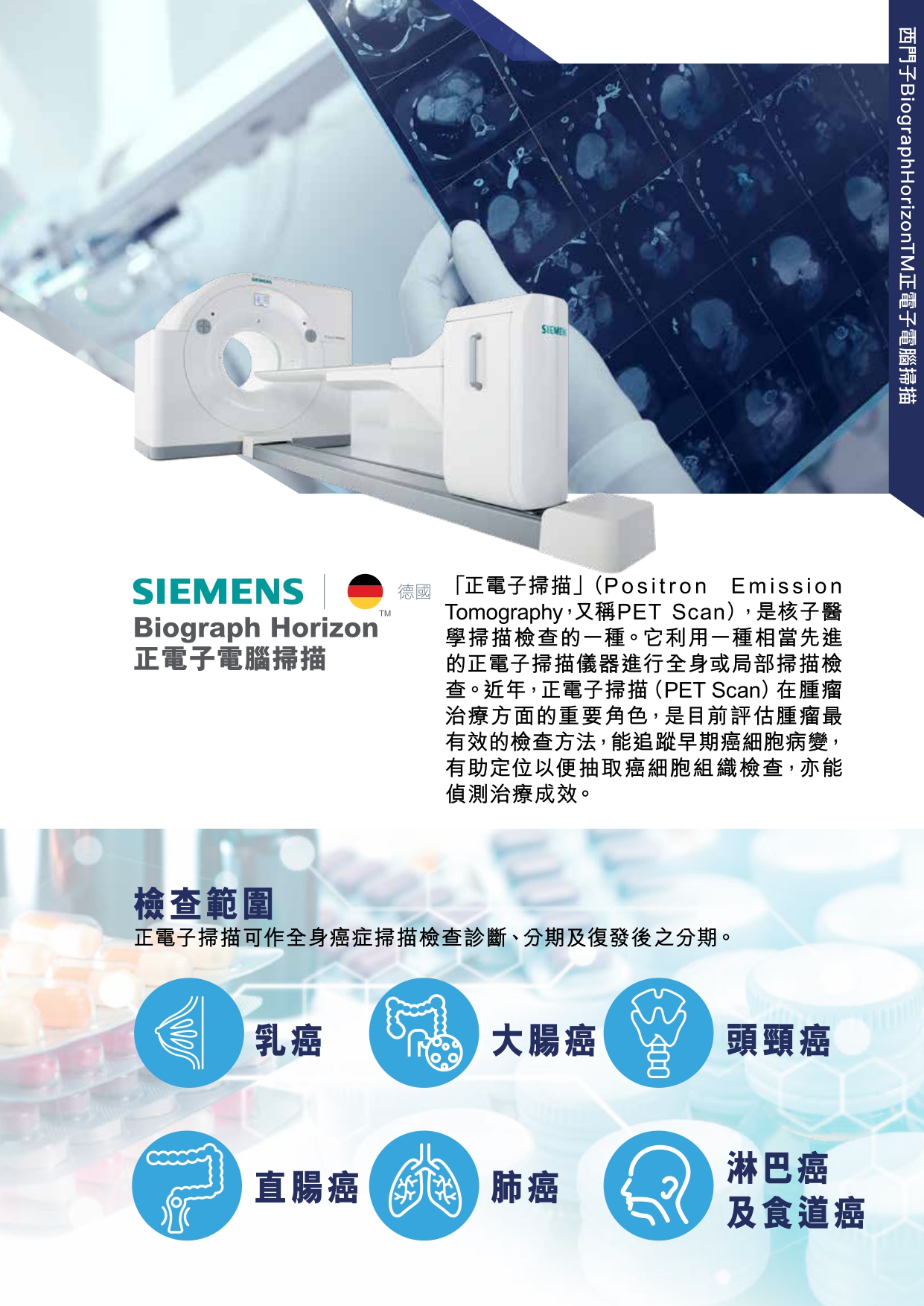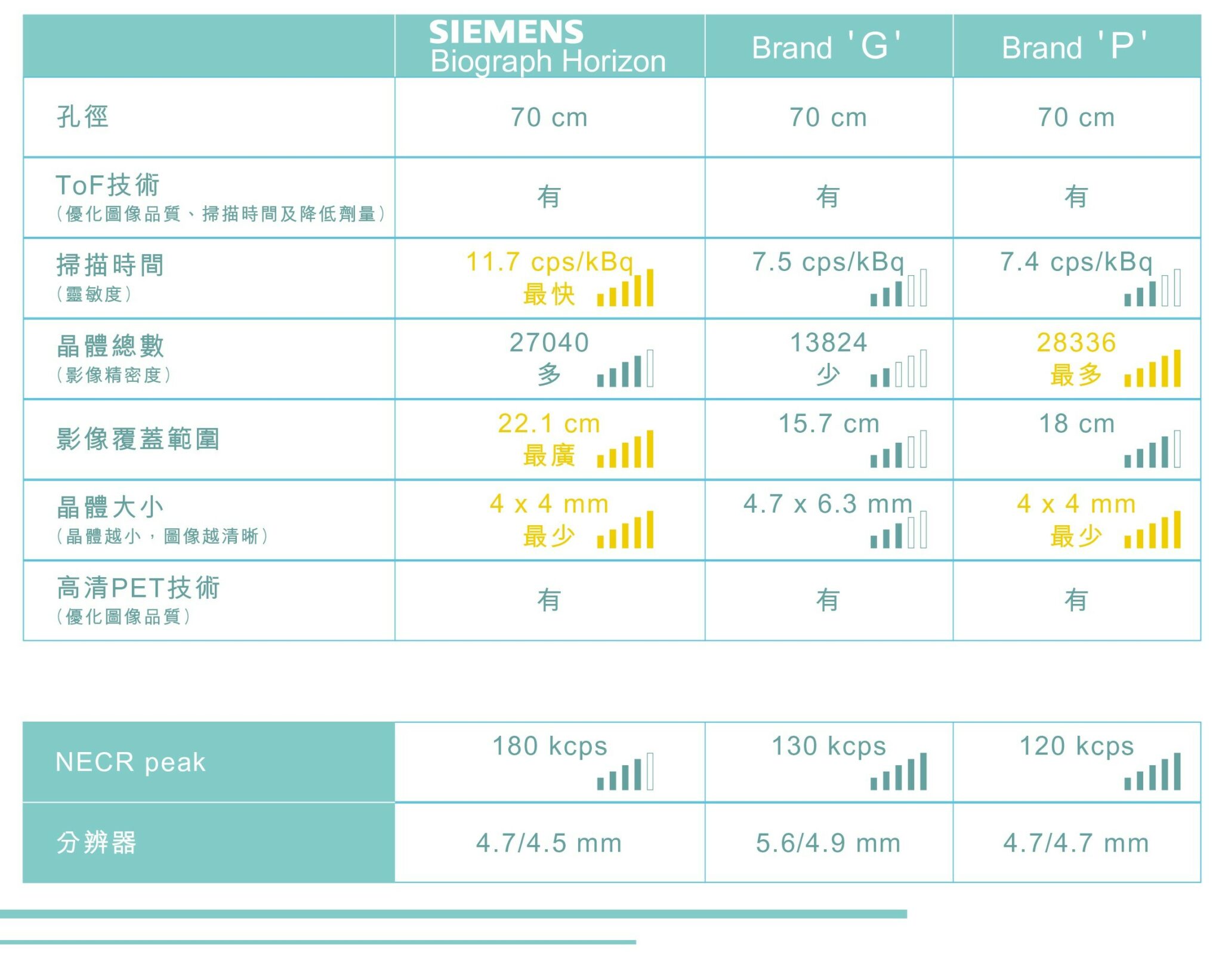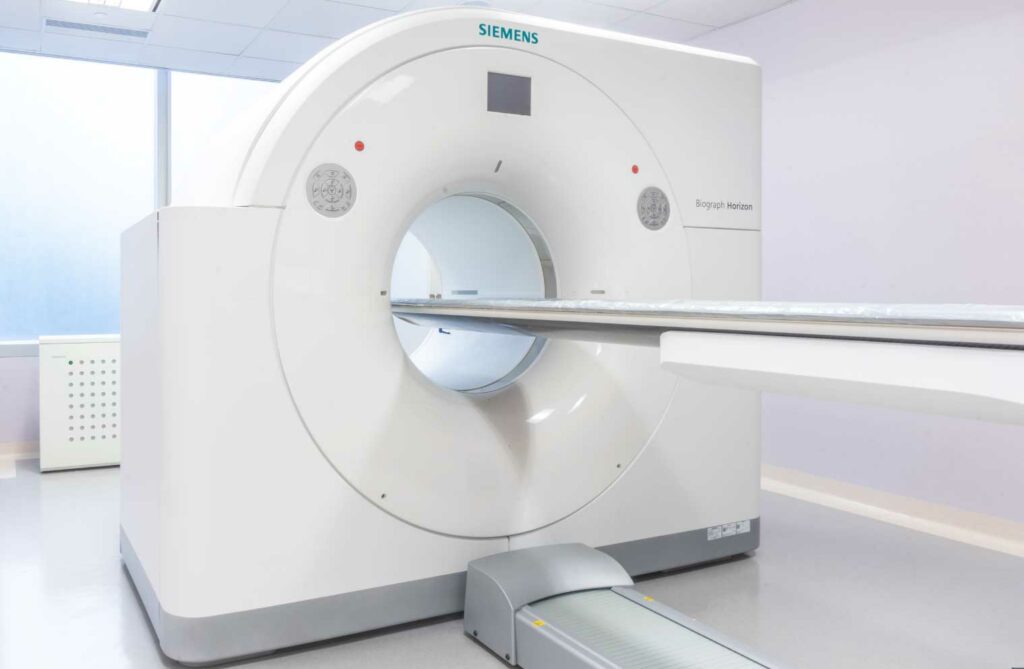
Contact Us
Positron Emission Tomography-Computed Tomography (PET-CT Scan)
Positron Emission Tomography-Computed Tomography (PET-CT Scan) is a combination of PET and CT technology. It can be used to evaluate and diagnose cancer, malignant tumour, neurological disorders, cardiovascular diseases, etc. The entire PET-CT scan procedure takes approximately 3-4 hours. Contact us for more details on the cost and points to note of the procedure.

PET-CT Scan Siemens Biograph Horizon Siemens Biograph Horizon PET-CT Scan
正電子電腦掃描作為目前主要的功能性非入侵式檢查,結合電腦掃描(CT)技術,主要應用於偵測腫瘤及診斷腦和心臟等領域疾病。它能有助於區分活/死組織及良性或惡性腫瘤/癌細胞的生長,為患者釋出最合適的建議。
The Siemens Biograph Horizon™ PET/CT scanners used in HKAI treatments provide fast and accurate imaging outcomes. The premium LSO-based scintillation crystals in the detectors developed by Siemens have been upgraded from 6.3mm to 4.00mm compared to the previous BGO-based PET/CT scanners for better image clarity. Moreover, the LSO scintillation crystals have significantly improved their signal-to-noise ratio and reduced the scanning time required. This, together with Siemens SAFIRE’s exclusive technology, reduces the radiation dose to patients by up to 60%.
What is Positron Emission Tomography-Computed Tomography (PET-CT Scan)?
正電子電腦掃描 (Positron Emission Tomography-Computed Tomogra-phy),簡稱正電子掃描或 PET-CT Scan,是一種功能性的醫學影像檢查,可提供某個身體器官或系統功能的詳細訊息,常用作評估和診斷癌症、腦部神經系統失調和心血管疾病,比其他影像技術(例如電腦斷層掃描和磁力共振成像掃描)更早檢測出癌症,亦可確定癌症是否正在擴散至其他身體部位,以及擴散至何處。在掃描前,放射師會將放射同位素藥物注入病人體內。掃描過程中,醫護人員會將放射性追踪劑注入病人體內,並使用PET 掃描儀器記錄病人的身體影像。攝影機將檢測出放射性追踪劑所釋放的輻射量,然後由電腦建構出受檢部位的多方位圖像。放射同位素藥物通常會積聚在患病組織中,而非健康的組織內。
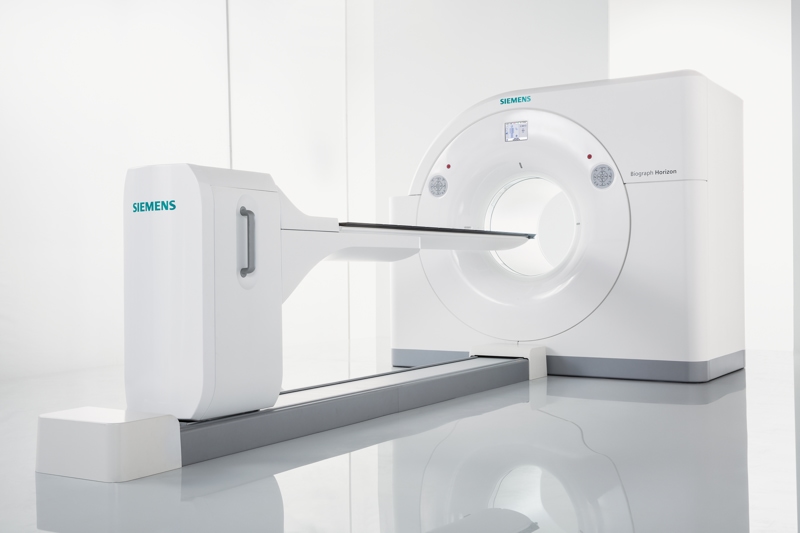
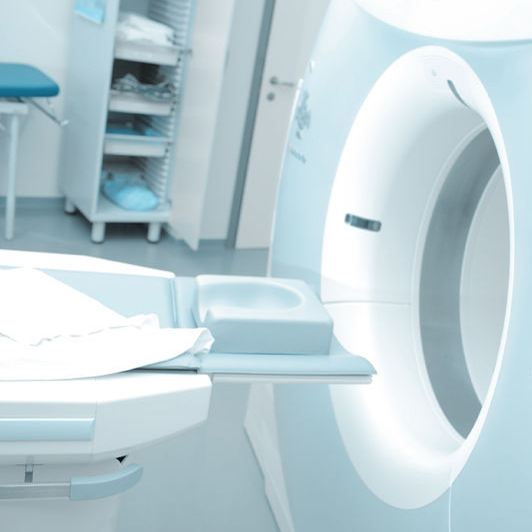
Leveraging the Combined Strength
PET Scan是診斷癌症的最有效方法之一,PET Scan能作全身的掃描,以發現隱藏的癌症,有助鑒別腫瘤的良、惡性腫瘤定位,準確程度高達90%以上,評估腫瘤療效,鑒別腫瘤復發和壞死以及放療生物靶區定位。擴散到身體其他部份的癌細胞亦會呈現攝取較多葡萄糖的現象,同樣可由PET Scan掃描檢查得到惡性腫瘤,準確的癌症分期,有助制定合適的緩解癌症方案,提高癌症的緩解機會。正子電腦斷層掃描融合了傳統PET﹝正子造影﹞和CT﹝Computed Tomography). It can detect the presence and metastasis, and pinpoint precisely the location of cancer cells through CT.
PET Scan Procedures
The entire PET-CT scan procedure takes approximately 3-4 hours. It includes pre-injection screening, measurement of fasting plasma glucose, and radiopharmaceutical injection. The patient has to lie still after the injection for about 1 hour to wait for the drug to be absorbed, followed by a full body scan (about 30 minutes). The patient will take another 1-1.5 hours of rest for the attenuation and metabolism of medication. Under certain circumstances, the patient will undergo another scanning procedure during this period.
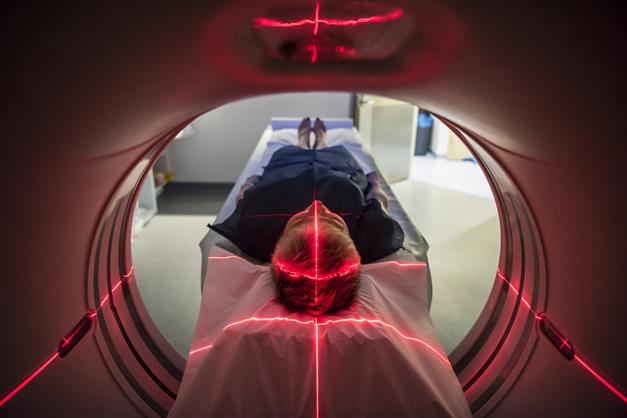
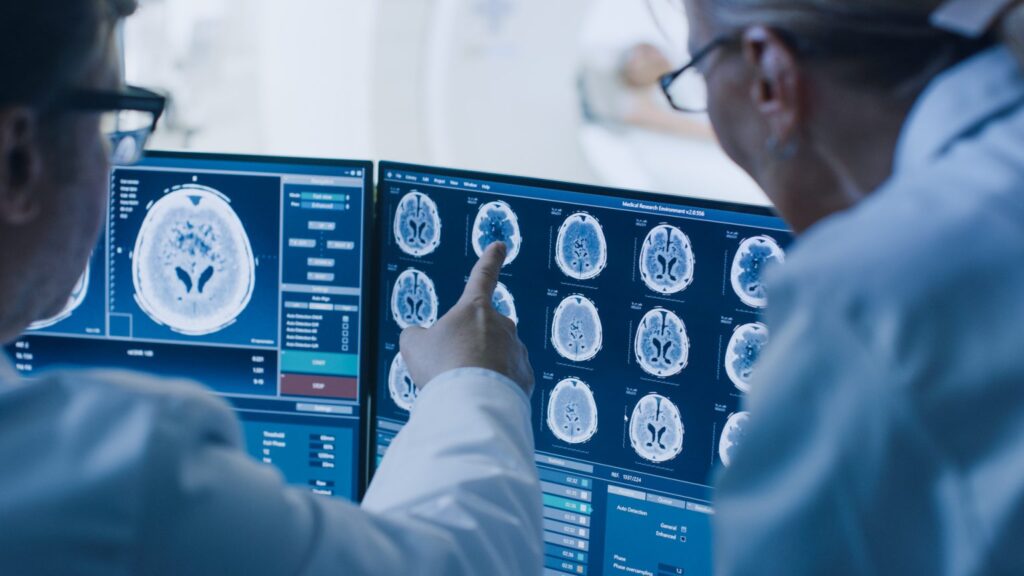
Points to Note
Please inform our medical staff if:
- Patients should not have undergone any barium x-ray examination 10 days prior to the PET-CT scan.
- A 6-hour fasting is required prior to the scan. Consumption of alcohol and beverages is prohibited (except water). Avoid medication with high sugar content (e.g. cough syrup, glucose). Avoid chewing gum or candy.
- A bland and easy-to-digest diet is recommended 1 day prior to the scan.
- Patients are advised to drink enough water, at least 6 to 8 cups of water 1 day prior to the scan.
- Avoid intense muscular activities such as strenuous exercise and heavy lifting.
- Pregnant and lactating women, people with unstable emotions, people with acutely persistent muscle cramps, and diabetic patients with poor blood sugar control should not be screened.
Guidelines for Patients with Diabetes
- Your appointment will be arranged in the morning as your blood sugar level will be lower at that time.
- Please follow your regular insulin and oral antidiabetic drugs instruction the day before the test. Fasting is required after midnight (except for water and non-glucose medication intake)
- Please do not inject insulin or take oral antidiabetic drugs on the day of examination.
- Patients are advised to eat right after the screening. You are recommended to have a half dose of IV insulin or a normal dosage of oral antidiabetic drugs during the meal after the scanning to avoid the risk of low blood sugar.
PET-CT service is available in the following centres:
| Langham Place Flagship Centre (EC Specialists Premium PHF No.: DP000104) L12, Langham Place Office Tower, 8 Argyle Street, Mong Kok (Mong Kok station Exit E1) |
| Argyle Centre 4/F, Argyle Centre Phase1,688Nathan Road, Mong Kok (Mong Kok station Exit D2) 4/F, Argyle Centre Phase1,688Nathan Road, Mong Kok (Mong Kok station Exit D2) |
| Tsim Sha Tsui (AcuScan Advanced Imaging) Room 209-213, Hong Kong Pacific Centre, 28 Hankow Road, Tsim Sha Tsui (Tsim Sha Tsui MTR Exit A1) Rm 210-213, 2/F, Hong Kong Pacific Centre, 28 Hankow Road, Tsim Sha Tsui (Tsim Sha Tsui station Exit A1) |
| Tsuen Wan Branch (AmMed Medical Diagnostic Center) Unit 1105, 11/F, CDW Building, 388 Castle Peak Road, Tsuen Wan, N.T. (Tsuen Wan station Exit A3) |
| 銅鑼灣分店 8/F Tower535,535Jaffe Road, Causeway Bay 8/F Tower535,535Jaffe Road, Causeway Bay |
| Central B/F & G/F EC Healthcare Tower (Central), 19-20 Connaught Road Central, Central (Central MTR Exit A1) B/F & G/F EC Healthcare Tower (Central), 19-20 Connaught Road Central, Central (Central MTR Exit A1) |
PET-CT Scan Q&A
A PET scan is an advanced imaging examination that offers detailed information on a particular body organ or specific function of the body. It is commonly used to evaluate and diagnose cancer, neurological disorders of the brain, and cardiovascular disease.
During the PET scan, a radiologist will inject a radioactive tracer into the patient’s body and images of the patient’s body are recorded with a PET scanner. A specialised camera can detect the radiation emitted by the radioactive tracer, and a multidimensional image of the examined area will be generated by the computer.
PET Scan 掃描是「Positron Emission Tomography」(「正電子斷層掃描」),是屬於核子醫學的技術,和 CT Scan 和 MRI Scan 兩種最大的不同是,正電子掃描屬於功能性的檢查(CT 和 MRI 是結構性檢查)。病人需要注射帶有放射性的藥物(一般來說是葡萄糖),如身體有癌細胞、炎症、感染等等,其活躍性會被顯示出來。如果以攝影來做比喻的話,PET Scan 就像一個紅外線相機,而 CT 就是一部高清數碼相機。現在很多癌症病人進行的 PET-CT scan 就是結合了 PET 的功能性及 CT 的結構性檢查,所以正電子斷層掃描非常全面。建議每個病人應該和專家討論,並結合臨床病徵,以便確定最佳的診斷方法。
PET 掃描主要用作檢測和監控包括癌症、腦部神經障礙和心血管疾病等病症,比其他影像技術(例如電腦斷層掃描和磁力共振成像掃描)更早檢測出癌症,亦可確定癌症是否正在擴散至其他身體部位,以及擴散至何處。
PET 掃描可顯示大腦哪個部位導致腦癇發作,有助制定腦癇症的緩解手術。這檢查也同時用作評估阿茲海默症和柏金遜症,產生的影像可精確地指出未正常運作的大腦區域。及早發現神經系統失調可讓病人接受更有效的舒緩。
- Patients should not have undergone any barium x-ray examination 10 days prior to the PET-CT scan.
- A 6-hour fasting is required prior to the scan. Consumption of alcohol and beverages is prohibited (except water). Avoid medication with high sugar content (e.g. cough syrup, glucose). Avoid chewing gum or candy.
- A bland and easy-to-digest diet is recommended 1 day prior to the scan.
- Patients are advised to drink enough water, at least 6 to 8 cups of water 1 day prior to the scan.
- Avoid intense muscular activities such as strenuous exercise and heavy lifting.
- Pregnant and lactating women, people with unstable emotions, people with acutely persistent muscle cramps, and diabetic patients with poor blood sugar control should not be screened.
The radiopharmaceutical (also known as a tracer) is injected into the patient's body prior to the scan. The radiotracers usually accumulate in diseased tissues more than in healthy tissues. The images of the body are then acquired by a gamma camera in the PET scanner. The camera detects the positrons emitted from the tracers in the body, and a multi-dimensional image of the examined body part will eventually be generated by the computer. The patient has to lie still after the injection for about 1 hour to wait for the drug to be absorbed, followed by a full body scan (about 30 minutes). The patient will take another 1-1.5 hours of rest as the radiotracer becomes less radioactive over time. The risk of having side effects is low.
PET scans are rarely recommended for pregnant and breastfeeding women.
Children are more susceptible to radiation than adults and are not suitable for PET scanning.



